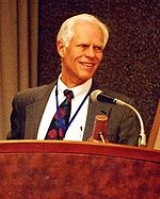
William M. Hartmann
Encyclopedia
William M. Hartmann is a noted physicist, psychoacoustician, author, and former president of the Acoustical Society of America
Acoustical Society of America
The Acoustical Society of America is an international scientific society dedicated to increasing and diffusing the knowledge of acoustics and its practical applications.-History:...
. His major contributions in psychoacoustics
Psychoacoustics
Psychoacoustics is the scientific study of sound perception. More specifically, it is the branch of science studying the psychological and physiological responses associated with sound...
are in pitch
Pitch (music)
Pitch is an auditory perceptual property that allows the ordering of sounds on a frequency-related scale.Pitches are compared as "higher" and "lower" in the sense associated with musical melodies,...
perception, binaural
Binaural
Binaural literally means "having or relating to two ears." Binaural hearing, along with frequency cues, lets humans and other animals determine direction of origin of sounds...
hearing, and sound localization
Sound localization
Sound localization refers to a listener's ability to identify the location or origin of a detected sound in direction and distance. It may also refer to the methods in acoustical engineering to simulate the placement of an auditory cue in a virtual 3D space .The sound localization mechanisms of the...
. Working with junior colleagues, he discovered several major pitch effects: the binaural edge pitch, the binaural coherence edge pitch, the pitch shifts of mistuned harmonics, and the harmonic unmasking effect. His textbook, Signals, Sound and Sensation, is widely used in courses on psychoacoustics. He is currently a professor of physics at Michigan State University
Michigan State University
Michigan State University is a public research university in East Lansing, Michigan, USA. Founded in 1855, it was the pioneer land-grant institution and served as a model for future land-grant colleges in the United States under the 1862 Morrill Act.MSU pioneered the studies of packaging,...
.
Hartmann was born in Elgin, Illinois,USA on 28 July 1939. He studied electrical engineering and physics at Iowa State University in Ames, IA, (BSEE 1961). Supported by a Rhodes Scholarship (Iowa and Lincoln, 1961) he studied theoretical physics with Sir Roger Elliott at Oxford University in England (D.Phil. - condensed matter theory 1965). He continued research in condensed matter theory as a post-doctoral scholar at Argonne National Laboratory in Argonne Illinois (1965–1968).
In 1968 Dr. Hartmann joined the Department of Physics (now the Department of Physics and Astronomy) at Michigan State University in East Lansing where he is still employed as a professor of physics. His work in condensed matter theory primarily involved lattice vibrations (phonons) in defective crystals, where he was the first to show how to include short-range order among defects in the vibrational theory of alloys. Later, he studied the electron-phonon interaction in metals where he made the first calculation of the latent heats of melting metals.
In 1974 he began teaching an undergraduate course on musical acoustics which inspired his interest in human hearing. In 1976 he reinvented himself as a psychoacoustician, and he has continued to work in psychoacoustics, musical acoustics, and signal processing since that time. He has been an adjunct professor in the MSU Department of Psychology since 1979.
In 1981-82 Dr. Hartmann was a visiting scientist at the Institute for Research on Acoustics and Music (IRCAM
IRCAM
IRCAM is a European institute for science about music and sound and avant garde electro-acoustical art music. It is situated next to, and is organizationally linked with, the Centre Pompidou in Paris...
) in Paris. He subsequently served at IRCAM
IRCAM
IRCAM is a European institute for science about music and sound and avant garde electro-acoustical art music. It is situated next to, and is organizationally linked with, the Centre Pompidou in Paris...
as acting director of acoustics (1982–1983) and as consultant (1983–1987). He was an associate editor of Music Perception from 1988–1997, and he is currently the editor-in-chief of the Springer series Modern Acoustics and Signal Processing.
Dr. Hartmann's published work in psychoacoustics deals with pitch perception, signal detection, modulation detection and localization of sound. His pitch perception research is characterized by an unusual emphasis on tonotopically local effects such as pitch shifts, presumably originating in the auditory periphery. His sound localization research has emphasized signal confusions caused by room reflections and the strategies used by listeners to cope with them.
He has written one textbook, Signals, Sound, and Sensation (published by Springer-Verlag - AIP Press, 1997) and he was co-editor of the Springer Handbook of Acoustics (2007). He is the author of over 75 peer-reviewed journal articles. His patented (USPTO# 6,925,426)
protocol for high-fidelity sound recording with uniquely realistic spatial characteristics became a New York Times science feature by James Glanz, November 16, 1999 "Recorded music gets dose of reality".
In 2001 Dr. Hartmann received the Distinguished Faculty Award from Michigan State University and the Interdisciplinary (Helmholtz-Rayleigh) ASA Silver Medal
ASA Silver Medal
The ASA Silver Medal is an award presented by the Acoustical Society of America to individuals, without age limitation, for contributions to the advancement of science, engineering, or human welfare through the application of acoustic principles or through research accomplishments in acoustics...
from the Acoustical Society of America.
Dr. Hartmann has been a fellow of the Acoustical Society of America
Acoustical Society of America
The Acoustical Society of America is an international scientific society dedicated to increasing and diffusing the knowledge of acoustics and its practical applications.-History:...
since 1983. He was chairman of the Technical Committee on Musical Acoustics and a member of the Society's Executive Council. He gave the Society Tutorial at the spring meeting in 1996 entitled, "Pitch, Periodicity and the Brain." He served as vice president of the Society (1998–1999) and as president (2001–2002). As president, he worked to enhance the Society's connections with allied organizations such as the Institute for Noise Control Engineering, and to expand the Society's international presence.

